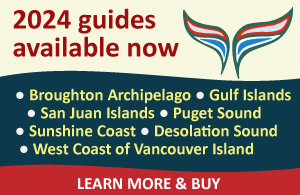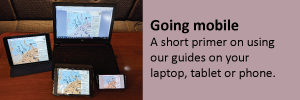Preparing to cross Nahwitti Bar

They will know that the lovely anchorage at Bull Harbour is from where most boaters set off to cross the bar only minutes away, and that from just outside the anchorage they can inspect by binoculars the seas over Nahwitti Bar. And if both wind and current are moderate and running the same direction, it should be safe to head off.
They will also know that if they have any doubts they can return to the shelter of Bull Harbour.

When we crossed Nahwitti Bar in 2020, heading counter-clockwise around the island, it was a windless day at slack water. We hobby-horsed for some minutes in a low swell as we passed over the bar, though it was otherwise uneventful. But we could see that in a full ebb, and with typical summer winds in opposition, it would have been a different story.
From extreme depths a short distance out to sea, the seabed rises quickly to the shallows of Nahwitti Bar which extend less than a mile across Goletas Channel, from the west end of Hope Island to the Tatnall Reefs which lie north/south just off Vancouver Island. Vast quantities of water funnel across this slip of a seaway during tidal ebbs and floods.
A strong west wind opposing a fast ebbing tidal stream can create heavy seas over the bar which are dangerous to small vessels. In westerly gales, the breaking seas are best avoided by even large ships.

Tidal streams flow east on the flood and west on the ebb in Goletas Channel. At full flow, the streams can attain speeds of 5.5 knots over Nahwitti Bar. The duration of the high water slack is about 12 minutes, while low water slack is about 17 minutes.
Heavy rips and overfalls form when the tidal stream is opposed by strong winds. These rips and overfalls can be dangerous to small craft. If crossing with an ebb, do so only if there is little to no west wind.
Another option is to avoid crossing the bar entirely. The Canadian Hydrographic Service’s Sailing Directions advises that vessels heading west can follow the Vancouver Island shoreline, passing south of Tatnall Reefs and then north or south of Weser Island before rounding Cape Sutil.
Along this route, always be aware of your position, watching your depth sounder and taking care not to inch too close to shore or shoals offshore. If the current is flowing with you, there will be some acceleration from it.
The seas at Cape Scott can be turbulent during times of high winds against flow. The route via Cape Sutil gives you the option of timing your arrival at Cape Scott for slack tide, since you are not restricted to crossing Nahwitti Bar at slack along this route.

The bay east of Cape Sutil is a good anchorage in typical summer weather, with protection from all but easterlies. Anchoring here also provides the option of transiting Goletas Channel at slack tide, spending a night on anchor at Cape Sutil, then rounding Cape Scott the next day at slack.
However, the Cape Sutil route is not advised in strong northwest or west winds as boaters can be exposed to dangerous swells that sometimes break over the entire reef.
If this will be your first time experiencing ocean swells, it may take some time to get your sea legs, but once you do, it will be exhilarating to feel the ocean surge. A good idea is to have food prepared in advance and a Thermos of your favourite hot beverage on hand to avoid going below deck, where the first stirrings of sea sickness may hit. Check out our quick, easy and nutritious pre-made grab ‘n’ go breakfasts/lunches for heavy weather dining.
Stow and secure anything that can possibly move around, because it will. We put cushions and blankets in lockers, including the dish cupboard, so we will not have to listen to things banging into each other. Even if it’s not going to break, listening to the rattle and thump just adds to the anxiety.

VHF weather forecasts for Vancouver Island North are continuous. Especially helpful are lighthouse reports from Cape Scott and Quatsino Sound, 15 nautical miles south of Cape Scott.
If you have radar, make sure it’s up and running in case fog quickly rolls in. Remember, for the same reason you do, large fishing boats also time their crossings of the bar.
For some, Nahwitti Bar and Cape Scott are deterrents to cruising down the west coast of Vancouver Island, but patience is the best first mate. Take your time; don’t sail to a schedule. If the forecast is for unpleasant conditions, stay put.
~~~
See also a video (below) of a virtual PowerPoint presentation we gave about the West Coast of Vancouver Island at the Vancouver Island Boat Show. The 40-minute video includes a short discussion of Nahwitti Bar.

Fair winds and stay safe.



















Great info and writing. Makes me want to cross that Nahwitti bar.
Will enjoy our trip around the island ,with the help from your guide . M.V. Old Crow
That was a great video folks! It sure does make one want to spread their wings and fly around to view all those beautiful anchorages and vistas. Thank you both for this!